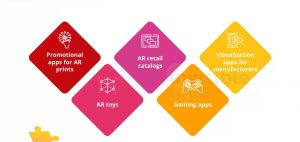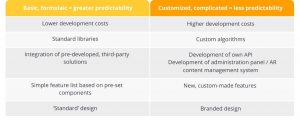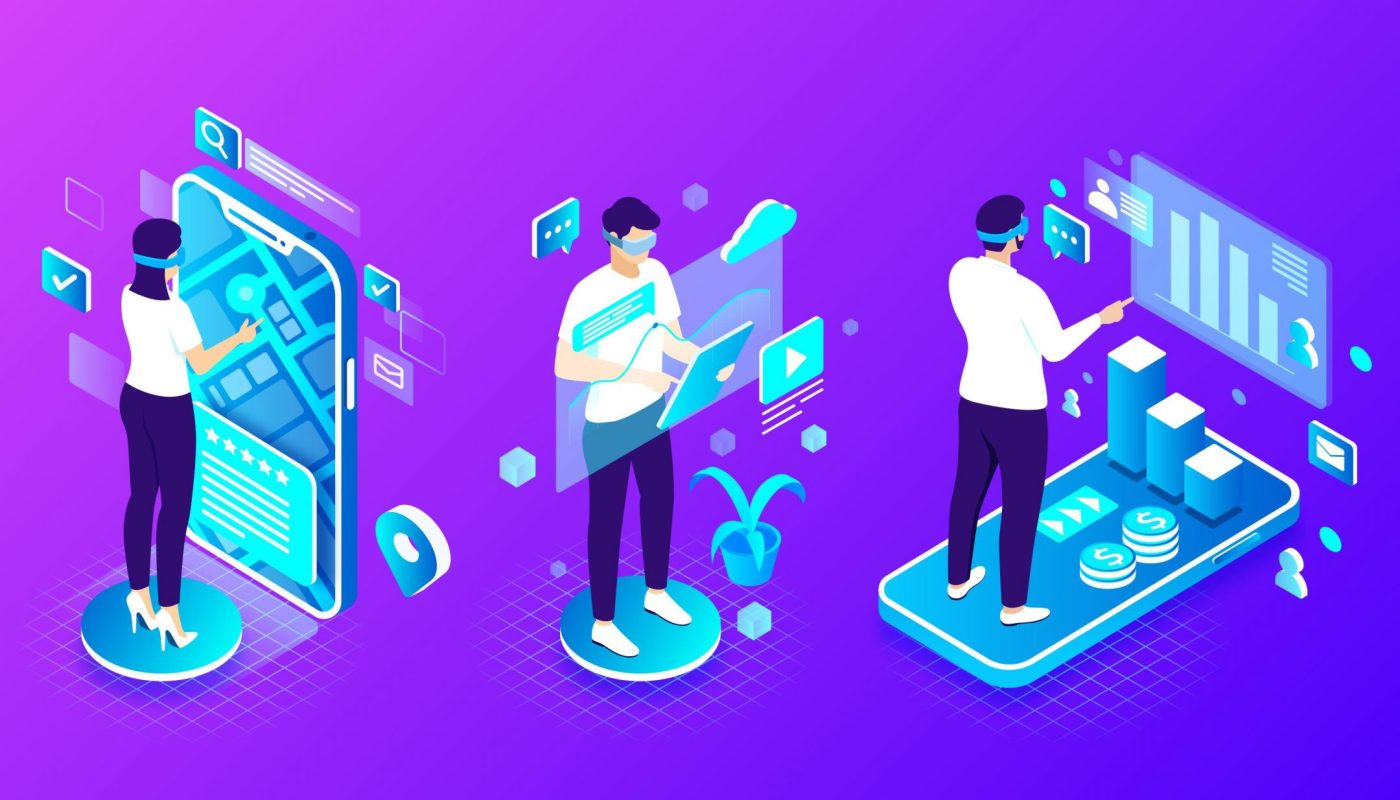Augmented Reality costs are, at times, challenging to nail down because some types of work on a project might take longer due to unforeseen challenges (e.g., working with a beta version of a new feature, changes in recognition algorithms, OS updates, etc.) This is why it is crucial to select a reliable partner able to understand your business and your business goals, a partner who offers a relevant solution specific to your needs—and keeps promises made.
Here is what is possible:

What tops a prospect’s list of concerns when looking for an experienced Augmented Reality app development company?
Cost.
“How much does it cost to get an Augmented Reality app developed for my business?”
When it comes to pricing, there is no clear-cut formula—just estimates. Augmented Reality app development costs vary greatly based on different app types: it ranges from $5,000–$10,000 for a simple demo app developed in 160 working hours to $300,000+ for a feature-rich, custom-built app that takes nine months and longer to develop. But estimates cannot clearly factor in the risk cost of unforeseen challenges—challenges that must be addressed with sound expertise and experience. The more complicated the app, the greater the number of unforeseen challenges.
Predicting how much Augmented Reality will cost
There are three main components to consider and include when pricing an AR app development costs: scope of work, timeline, and development team:
- Scope of work – features, complexity of app logic, plus necessary work to develop the app, including QA activities, project management, launching/publishing in app stores, post-launch support and maintenance, etc.
- Timeline – rush means a rise in costs: the tighter the deadline, the more expensive the development (exceptions to this rule include prototypes and MVPs).
- Development team – total costs include timeline multiplied by a team’s hourly rate; hourly rate depends on team’s experience and geo-location.
Returning to complicated, customized apps: the greater the customization an app requires, the greater the unpredictability when determining price, the greater Augmented Reality costs to integrate into an app.
For example:

How do different project types affect how much AR apps cost? Let’s consider 2 cases below.
- simple demo / MVP (minimum viable product) app
- more advanced app with some custom features
Remember: Visual design is absolutely crucial to obtain a fairly close estimate. No reliable estimate on Augmented Reality app development costs is possible without awareness of the visual part of the future app.
1 A simple demo / MVP app
Demo and MVP apps are used to present an idea to a target audience in an engaging manner. These apps usually have a simple structure and user-friendly, intuitive UX so that an average user can enjoy it on any smartphone—even a relatively old one. A good example of an Augmented Reality demo app is AR Building Blocks by Invisible Toys letting users play with augmented wooden blocks on any horizontal surface.
This app usually has 1–5 AR models onboard, 1 key feature and requires zero learning from users. Basic moves are accessible such as view, rotate, pile 3D models, take a snapshot, etc.
To save costs, a demo app seldom includes a custom logo.
How much does AR cost in this case? Costs include the following:
- Design and wireframing – 16+ hours
- Programming – 40+ hours
- Integration of 3D models – 1 hour / depending on source format and number of models
- Publishing in stores – Android – 4 hours, iOS – 8 hours
Please note: Invisible Toys can provide a simple demo AR app and launch within 20–22 business days or 160–176 working hours. Definitely “app enough” to test target audience reaction and decide whether Augmented Reality is the right growth direction. (For the vast majority of businesses, having a demo AR app results in a tremendous step up.
The following examples include simple demo / MVP AR apps you can get for your business:
- Marker-based (includes marker plus model integration, menu upon request, and a splash screen)
- Location-based (up to five models)
- Markerless (includes model/video integration, menu upon request plus splash screen)
- AR catalogue (iOS / Android mobile app plus administration panel and up to five models)
2. A simple app with several customized features
A simple app with custom features has a branded logo and a higher number of features than the MVP to satisfy user’s needs / wants. This kind of AR app can be used as a configurator or catalogue, including the following features:
- choose an item
- change and invert colours
- visualize item inside a room
- take a photo
- save and share with friends
- and more…
Different kinds of configurators fit within this category. For example, the Roomle furniture configurator makes it possible to choose a type of furniture, set up the chosen size, and see its real dimensions and compatibility with a room interior via the smartphone screen.
It is also possible to add a cart feature to this kind of app: chosen models are available for purchase, and voila, a new, convenient sales channel, opens.
Development effort and cost of Augmented Reality are usually distributed in the following way:
- Sign in – 12 hours: integrating APIs from the back end
- Catalogue – 24 hours: menu grid with items
- Sharing – 4 hours iOS + 4 Android
- Cart – 8 hours
- Analytics system – 24+ hours, depends on the system
- API integration – 16+ hours per API, depends on API documentation and integration complexity
- Back-end development – back end must be estimated as a part of specific features
App development rates
Hourly rates vary depending on the developers’ location. Rates decrease from west to east: US- and Canadian-based companies have the highest rates, followed by Western Europe. Next comes Latin America and Eastern Europe. Eastern-Asian countries, such as China, India, and Vietnam, offer the lowest development prices, but the lowest price might mean cheapest and, consequently, come at a cost. Also, do not underestimate the role cultural differences play when choosing a development team.
According to pricing on the website of the Washington-based research company, Clutch, development charges vary, as follows:
- North America: from $150/hr
- South America: from $30-50/hr
- Western Europe: from $70-100/hr
- Eastern Europe: from $25-30/hr
- India: from $15-30/hr
- Australia: from $ 100-110/hr
The hourly rate can vary depending on the amount of work and its complexity, but the rate includes the per-hour work rate for each team member unless otherwise specified.
An important note: look for professionals who place a high value on their work and reputation. Do not search for and hire the cheapest development team in the market. You might win the app development lottery—then again, you might not. Great developers invest their time and money into mastering their skills: they are not likely to work for low rates. In return, you get quality and lowering Augmented Reality app development costs in the long run.
In conclusion, Look for a responsible person or team who will keep an eye on your app, ensuring it works smoothly. This is the best way to save on Augmented Reality costs.
Invisible Toys is IT Craft’s special department focused solely on outsourced Augmented Reality, VR, Unity 3D development, and Web apps for visualization. Since 2001, IT Craft has been in the outsourcing software development market, witnessed and been immersed in several technological pivots. Crucial to success in breaking new ground is a dynamic mixture of technological flexibility and in-depth practical experience. Knowing this, the company invests time and resources in its developers to continually learn and apply their new knowledge. Find more about them on invisible. toys/about/
you can read my other posts on Augmented and Virtual reality on akpabio precious 1 / 1 — Major Online Business and Marketing (hslu.ch)



Do you know how to arrange home in neatly? In this article, the author shared some ideas for organizing items. You can try out these methods for arranging your room, at last, your room becomes neat and attractive. hi everyone https://www.quality-assurance-solutions.com/